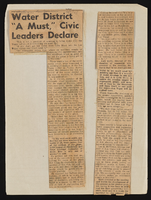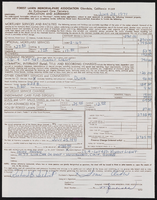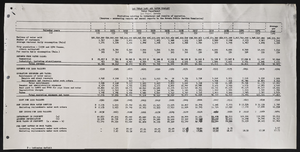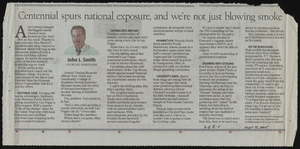Search the Special Collections and Archives Portal
Search Results
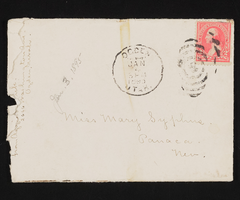
Letter and envelope from Aggie Herrick Ogden, Utah. to Mary Etta Syphus, Panaca, Nevada
Date
1895-01-03
Archival Collection
Description
From the Syphus-Bunker Papers (MS-00169). The folder contains an original handwritten letter, an envelope, a typed transcription of the same letter, and a copy of original letter attached.
Text
Audio clip from interview with Charles Salton by George Green, April 23, 1976
Date
1976-04-23
Archival Collection
Description
Part of an interivew with Charles Salton on April 23, 1976. In this clip, Salton discusses his partnership with Larry Larkin and building in Las Vegas.
Sound
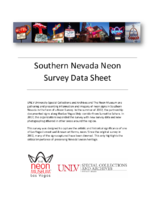
The Beat Coffeehouse Neon Survey document, September 17, 2017
Date
2017-09-17
Archival Collection
Description
Information about the The Beat Coffeehouse sign that sits at 520 Fremont St.
Site address: 520 Fremont St
Sign owner: Michael and Jennifer Cornthwaite
Sign details: This location opened in 2009, but closed in 2016. It will reopen as Eureka!, which is a chain of restaurants based in California.
Sign condition: 5- was a relatively new sign and shined brightly
Sign form: Hanging sign
Sign-specific description: This sign was skeletal neon making the letters "the beat" in a bubble letter font. The word 'the' lights up blue and 'beat' is red neon.
Sign - type of display: Neon
Sign - media: Steel
Sign environment: This location is in the Fremont East District on Fremont and 6th Street in the Emergency Arts Center.
Sign - date of redesign/move: Currently this sign is not visible from public view
Sign - thematic influences: This sign showcases a good use of skeletal neon.
Sign - artistic significance: The property's decor is representative of the bohemian, indie, hipster trend of the mid 2000s into the the 2010s.
Survey - research locations: Review Journal article https://www.reviewjournal.com/entertainment/food/the-beat-coffeehouse-in-downtown-las-vegas-to-close-later-this-year/ , The Beat website http://www.thebeatlv.com/ , Las Vegas Weekly article https://lasvegasweekly.com/intersection/2016/jul/12/losing-the-beat-coffeehouse-detriment-to-downtown/ , Vegas Eater website https://vegas.eater.com/2016/9/26/13051480/the-beat-coffeehouse-closes
Surveyor: Wyatt Currie-Diamond
Survey - date completed: 2017-09-17
Sign keywords: Neon; Hanging
Site address: 520 Fremont St
Sign owner: Michael and Jennifer Cornthwaite
Sign details: This location opened in 2009, but closed in 2016. It will reopen as Eureka!, which is a chain of restaurants based in California.
Sign condition: 5- was a relatively new sign and shined brightly
Sign form: Hanging sign
Sign-specific description: This sign was skeletal neon making the letters "the beat" in a bubble letter font. The word 'the' lights up blue and 'beat' is red neon.
Sign - type of display: Neon
Sign - media: Steel
Sign environment: This location is in the Fremont East District on Fremont and 6th Street in the Emergency Arts Center.
Sign - date of redesign/move: Currently this sign is not visible from public view
Sign - thematic influences: This sign showcases a good use of skeletal neon.
Sign - artistic significance: The property's decor is representative of the bohemian, indie, hipster trend of the mid 2000s into the the 2010s.
Survey - research locations: Review Journal article https://www.reviewjournal.com/entertainment/food/the-beat-coffeehouse-in-downtown-las-vegas-to-close-later-this-year/ , The Beat website http://www.thebeatlv.com/ , Las Vegas Weekly article https://lasvegasweekly.com/intersection/2016/jul/12/losing-the-beat-coffeehouse-detriment-to-downtown/ , Vegas Eater website https://vegas.eater.com/2016/9/26/13051480/the-beat-coffeehouse-closes
Surveyor: Wyatt Currie-Diamond
Survey - date completed: 2017-09-17
Sign keywords: Neon; Hanging
Text

Interview with Linda (Mack) Smith, October 6, 2006
Date
2006-10-06
Archival Collection
Description
Narrator affiliation: Deputy Manager Nevada Operations Office, U.S. Department of Energy; Nevada Test Site Historical Foundation
Text
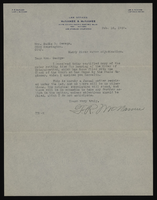
Correspondence, F.R. McNamee to Sadie George
Date
1917-05-24
Archival Collection
Description
This folder is from the "Correspondence" file of the Sadie and Hampton George Papers (MS-00434)
Text
Pagination
Refine my results
Content Type
Creator or Contributor
Subject
Archival Collection
Digital Project
Resource Type
Year
Material Type
Place
Language
Records Classification


